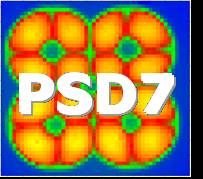Speaker
Prof.
Vladimir Peskov
(Leonard de Vinci University, France)
Description
In the last few years several groups and companies tried to develop
mammographic scanners based on GaAs, Si solid -state detectors or
high -pressure Xe gaseous detectors [1-3]. The main advantages of
the scanner system are the simplicity of the design (1D detector)
and the readout electronics and hence a low cost.
We have developed and successfully tested an innovative approach in
the X-ray scanning systems which combines the advantages of high
stopping power and a high position resolution typical for solid-
state detectors with high avalanche multiplications offered by
gaseous detectors. A novel scanner prototype consists of a gas
chamber (filled with Ar-based gas mixture at p=1atm) inside which a
1D hybrid gaseous detector was installed; the last one was an edge-
on illuminated capillary plate (the X-ray converter) combined with a
parallel-plate gas multiplication structure. The capillary plate
(CPs) tested were made of lead glass and had thicknesses of 0,4-1
mm; the holes had diameter of 12, 25 or 50 μm and the wall thickness
was 2,5, 5 or 8 μm respectively. A readout plate was placed 0,4 mm
below the CP. It was a ceramic plate with Cr strips of a 50 μm
pitch. Strips were connected to an ASIC having a digital readout.
The X-ray beam (with energy of 19-30 keV) was collimated by a slit
of 50 μm in width. The collimated X-ray beam enters the CP in
between of its anode and cathode surface and parallel to them (edge-
on illuminated geometry). Such a geometrical arrangement allows one
to achieve a high stopping power and at the same time does not
require very high accuracy in the beam alignment with respect the
CP. Photo (and Compton) electrons liberated from the thin walls of
the CP entered the capillary holes and created there microtracks of
primary electrons. Under the influence of the electric filed applied
between the capillary electrodes, the primary electrons drifted
through the capillary holes and finally were the extracted to the
gap between the CP and the readout plate. A voltage of 1-2 kV could
be applied between the CP and the readout plate which made it
possible for avalanche multiplication to take place in this region.
At a gas gain of ≥104 the readout electronic detected primary
photoelectrons with a 100% efficiency
The usual glass CP operate without noticeable charging up effects at
counting rates of 50 Hz/mm2 and hydrogen -treated CP -up to 105
Hz/mm2. The efficiency of the hybrid detector was, depending on
energy, between 8 and 42 %, position resolutions of 50 μm in
digital form. Images of several objects and a mammography phantom
obtained with this detector will be demonstrated. Since the detector
operated in photon counting mode, high quality images could be
obtained at radiation dose of 3- 5 times less than with standard
mammographic technique. The developed scanner may open new
possibilities for medical imaging, for example mammography,
radiology (including security devices) crystallography and many
other applications.
References:
[1] See talks at the Proceedings of the Conference “Imaging –2000”,
NIM A471, 2001
[2] See talks at the Proceedings of the London Conf. On Position-
Sensitive Detectors, NIM A513, 2003 2002
[3] See talks at the Proceedings of the Conference “Imaging -2003”
NIM A525, 2004
Primary author
Prof.
Vladimir Peskov
(Leonard de Vinci University, France)




